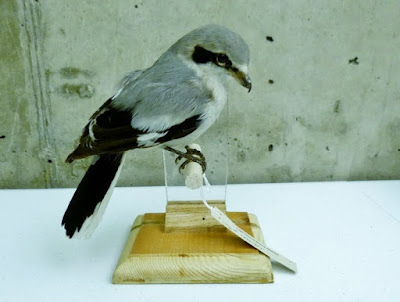Specimen of the Month: TWO Shrikes
I assigned a handful of collections tasks to the Museum's interns this summer--and while trying not to overwhelm them with more work than they already have, I still got a bit carried away. Thankfully, I noticed a glint of excitement in Norveig's eyes as she exited the specimen storage room having selected a special bird for our monthly display.
Although Norveig's passion for black bears followed her here after an internship at the North American Bear Center, bears are not all that excite her. Her face lights up any time someone mentions an insect, denounces invasive plant species, or comes along carrying a hitchhiking tick which she can preserve. That's right--this lady collects ticks. And despite keeping busy exploring the cornucopia of wildlife around her, she also appreciates a good taxidermy mount.
Norveig came across a particularly well preserved mount of a northern shrike (Lanius borealis) while scanning our storage shelves filled with taxidermy preparations of birds, mammals, reptiles, and so on. Only about a minute after entering the storage room, she found me in my back office to share her proposed display subject. While the quality of the mount was what initially appealed to her, our intern was aware of some of this species' interesting behaviors.
I liked the idea of highlighting this species, too. Northern shrike are fascinating little songbirds--equipped with adaptations much like a raptor, they're predatory with an intimidatingly hooked beak. We both agreed that visitors may appreciate viewing our mount of the bird who is wont to impale dead prey on prickly objects for later eating. I promptly instructed Norveig to go ahead with a northern shrike display--but then a second mount grabbed my attention.
 |
| This Northern Shrike was banded in January of 2008 while in its winter range of Northwoods Wisconsin. It was collected after having died in 2014. |
To the right of that first, I caught sight of another, familiar shrike. I knew that particular individual--I first saw it three years back when it was a new taxidermy piece. My mentor had taken note of three colored bands fasted to its legs--one each of metal, green, and blue. These of course were identification tags used by bird banders for scientific research. I remember having submitted the information, found in tiny inscriptions on each band, onto an online form and soon after receiving a hand-held certificate of appreciation for reporting our find. Since then, our shrike has been maintained with its certificate proudly fastened to the mount base. It's a story that, perhaps to only us and some researchers, would be of little interest to many. The information on the bird itself is interesting, sure, but would anyone else really care that I had a connection to the taxidermy piece years ago? Probably not. Still, I persuaded Norveig to get both shrikes on display.
 |
| Norveig Olson, the Museum's Pollinator Intern, selected this month's subject for display and created interpretive signage for visitors to read. |
Specimens tell a story--a complex truth which I attempt to explain to each inquiring visitor in as little words as possible. Their remains may add to the story of their species, catalog records may give habitat insight, or the prepared mount may hold a history of artistry and human connection. While I point towards the value that each specimen provides towards our broader understanding of life, each individual has an interesting history in its own right.
 |
| Evelyn, clearly amazed at the anatomy of a shrike, observes the Specimen of the Month display situated in the Museum's lobby. |
